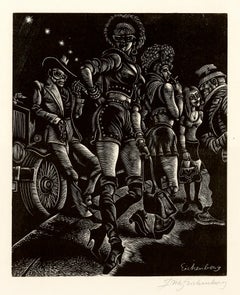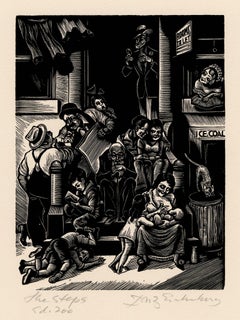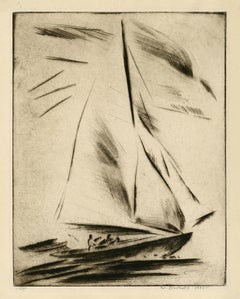Want more images or videos?
Request additional images or videos from the seller
1 of 3
Helios GomezAvenir (To Come) form Días de Ira (Days of Wrath) — Anti-Fascist Modernism1929-1930
1929-1930
$250List Price
About the Item
About the Seller
5.0
Recognized Seller
These prestigious sellers are industry leaders and represent the highest echelon for item quality and design.
Platinum Seller
Premium sellers with a 4.7+ rating and 24-hour response times
Established in 1995
1stDibs seller since 2016
334 sales on 1stDibs
Typical response time: 1 hour
Associations
International Fine Print Dealers Association
Authenticity Guarantee
In the unlikely event there’s an issue with an item’s authenticity, contact us within 1 year for a full refund. DetailsMoney-Back Guarantee
If your item is not as described, is damaged in transit, or does not arrive, contact us within 7 days for a full refund. Details24-Hour Cancellation
You have a 24-hour grace period in which to reconsider your purchase, with no questions asked.Vetted Professional Sellers
Our world-class sellers must adhere to strict standards for service and quality, maintaining the integrity of our listings.Price-Match Guarantee
If you find that a seller listed the same item for a lower price elsewhere, we’ll match it.Trusted Global Delivery
Our best-in-class carrier network provides specialized shipping options worldwide, including custom delivery.You May Also Like
"P{urim" From the suite "The Seven Festivals"
By David Sharir
Located in San Francisco, CA
This artwork titled "Purim" from the suite "The Seven Festivals" 1981, is an original colors serigraph on Arches paper by noted Israeli artist David Sharir,b. 1938. It is hand signed...
Category
Late 20th Century Modern Figurative Prints
Materials
Screen
"Succoth" From the suite "The Seven Festivals"
By David Sharir
Located in San Francisco, CA
This artwork titled "Succoth" from the suite "The Seven Festivals" 1981, is an original colors serigraph on Arches paper by noted Israeli artist David Sharir,b. 1938. It is hand sign...
Category
Late 20th Century Modern Figurative Prints
Materials
Screen
"Rosh Hashana" From the suite "The Seven Festivals"
By David Sharir
Located in San Francisco, CA
This artwork titled "Rosh Hashana" from the suite "The Seven Festivals" 1981, is an original colors serigraph on Arches paper by noted Israeli artist David Sharir,b. 1938. It is hand...
Category
Late 20th Century Modern Figurative Prints
Materials
Screen
Julian Trevelyan, Trafalgar Square, etching and aquatint
By Julian Trevelyan
Located in London, GB
To see our other views of London and our other Modern British Art, scroll down to "More from this Seller" and below it click on "See all from this Seller".
Julian Trevelyan (1910-19...
Category
1960s Modern Figurative Prints
Materials
Etching, Aquatint
$3,069
H 13.78 in W 18.9 in D 0.4 in
Julian Trevelyan, Tower Bridge, etching and aquatint
By Julian Trevelyan
Located in London, GB
To see our other views of London and our other Modern British Art, scroll down to "More from this Seller" and below it click on "See all from this Seller".
Julian Trevelyan (1910-19...
Category
1960s Modern Figurative Prints
Materials
Etching, Aquatint
$3,068
H 18.51 in W 13.39 in D 0.4 in
Female Figure - Lithograph by Benoit Andos - 19th Century
Located in Roma, IT
Lithograph realized by Benoit Andos in the mid-19th Century.
Good condition.
Category
19th Century Modern Figurative Prints
Materials
Lithograph
$287
H 10.83 in W 8.08 in D 0.04 in
Study/Falling Man (Series I)
By Ernest Tino Trova
Located in Missouri, MO
Study/Falling Man (Series I)
By. Ernest Tino Trova (American, 1927-2009)
24 x 24 inches
Wrapped to Foam Core
Signed Artist Proof Lower Right
Ernest Tino Trova (American, 1927-2009)
...
Category
1960s American Modern Abstract Prints
Materials
Screen
Study/Falling Man (Series II)
By Ernest Tino Trova
Located in Missouri, MO
Study/Falling Man (Series II), 1967
By. Ernest Tino Trova (American, 1927-2009)
24 x 24 inches
Wrapped on Foam core
Signed Artist Proof Lower Right
Ernest Tino Trova (American, 1927...
Category
1960s American Modern Abstract Prints
Materials
Screen
Study/Falling Man (Series I)
By Ernest Tino Trova
Located in Missouri, MO
Study/Falling Man (Series I), 1967
By. Ernest Tino Trova (American, 1927-2009)
24 x 24 inches
Wrapped to Foam Core
Signed Artist Proof Lower Right
Ernest Tino Trova (American, 1927-...
Category
1960s American Modern Abstract Prints
Materials
Screen
Study/Falling Man (Series II)
By Ernest Tino Trova
Located in Missouri, MO
Study/Falling Man (Series II), 1967
By. Ernest Tino Trova (American, 1927-2009)
24 x 24 inches
Signed Artist Proof Lower Right
Wrapped to Foam Core
Ernest Tino Trova (American, 1927...
Category
1960s American Modern Abstract Prints
Materials
Screen
More From This Seller
View All'The Pimp' — Graphic Modernism
By Fritz Eichenberg
Located in Myrtle Beach, SC
Fritz Eichenberg, 'The Pimp', wood engraving, 1980, artist's proof before the edition. Signed in pencil. Signed in the block, lower right. A fine, richly-inked impression, on cream wove paper, with full margins (2 3/16 to 3 1/2 inches), in excellent condition. Archivally sleeved, unmatted.
Image size 12 x 9 3/4 inches (305 x 248 mm); sheet size 18 x 14 inches (457 x 356 mm).
ABOUT THE ARTIST
Fritz Eichenberg (1901–1990) was a German-American illustrator and arts educator who worked primarily in wood engraving. His best-known works were concerned with religion, social justice, and nonviolence.
Eichenberg was born to a Jewish family in Cologne, Germany, where the destruction of World War I helped to shape his anti-war sentiments. He worked as a printer's apprentice and studied at the Municipal School of Applied Arts in Cologne and the Academy of Graphic Arts in Leipzig, where he studied under Hugo Steiner-Prag. In 1923 he moved to Berlin to begin his career as an artist, producing illustrations for books and newspapers. In his newspaper and magazine work, Eichenberg was politically outspoken and sometimes wrote and illustrated his reporting.
In 1933, the rise of Adolf Hitler drove Eichenberg, who was a public critic of the Nazis, to emigrate with his wife and children to the United States. He settled in New York City, where he lived most of his life. He worked in the WPA Federal Arts Project and was a member of the Society of American Graphic Artists.
In his prolific career as a book illustrator, Eichenberg portrayed many forms of literature but specialized in works with elements of extreme spiritual and emotional conflict, fantasy, or social satire. Over his long career, Eichenberg was commissioned to illustrate more than 100 classics by publishers in the United States and abroad, including works by renowned authors Dostoyevsky, Tolstoy, Charlotte and Emily Brontë, Poe, Swift, and Grimmelshausen. He also wrote and illustrated books of folklore and children's stories.
Eichenberg was a long-time contributor to the progressive magazine The Nation, his illustrations appearing between 1930 and 1980. Eichenberg’s work has been featured by such esteemed publishers as The Heritage Club, Random House, Book of the Month Club, The Limited Editions Club, Kingsport Press, Aquarius Press, and Doubleday.
Raised in a non-religious family, Eichenberg had been attracted to Taoism as a child. Following his wife's unexpected death in 1937, he turned briefly to Zen Buddhist meditation, then joined the Religious Society of Friends in 1940. Though he remained a Quaker until his death, Eichenberg was also associated with Catholic charity work through his friendship with Dorothy Day...
Category
1980s American Modern Figurative Prints
Materials
Woodcut
'The Steps' — WPA Era Graphic Modernism
By Fritz Eichenberg
Located in Myrtle Beach, SC
Fritz Eichenberg, 'The Steps', wood engraving, 1933, edition 200. Signed, titled, and annotated 'Ed. 200' in pencil. Initialed in the block, lower right. A superb, richly-inked impr...
Category
1930s American Modern Figurative Prints
Materials
Woodcut
'Brooklyn Bridge' — Iconic New York City Landmark
By Luigi Kasimir
Located in Myrtle Beach, SC
Luigi Kasimir, 'Brooklyn Bridge', color etching with aquatint, 1927, edition 100. Signed in pencil.
A superb impression, with fresh colors, on heavy, cream wove paper; with margins...
Category
1920s American Modern Landscape Prints
Materials
Etching, Aquatint
New Rochelle - Before the Wind
By Werner Drewes
Located in Myrtle Beach, SC
'New Rochelle - Before the Wind', drypoint, 1931, edition 30 (only a few impressions printed), Rose l.163. Signed, dated '1932' and numbered '1 – XXX' in ...
Category
1930s Modern Figurative Prints
Materials
Drypoint
Kris Dancer, Bali
By Albert Al Hirschfeld
Located in Myrtle Beach, SC
Al Hirschfeld, 'Kris Dancer, Bali', color lithograph, 1941, edition 1,000. Signed in the stone, lower right. A fine, clean impression, with fresh colors, on cream wove paper, the ful...
Category
1940s American Modern Figurative Prints
Materials
Lithograph
'Child Reaching' — 1940s American Modernism
By Will Barnet
Located in Myrtle Beach, SC
Will barnet, 'Child Reaching', woodcut, 1940, edition 25, Cole 82. Signed and titled in pencil. A fine, black impression, on fibrous Japan paper, with full margins (5/8 to 1 3/4 inch...
Category
1940s American Modern Figurative Prints
Materials
Woodcut
Still Thinking About These?
All Recently ViewedMore Ways To Browse
Joze Ciuha
Julian Opie Paper Heads
Kalman Kubinyi
Karl Gerich
Karl Neumann
Katarina Vavrova
Keith Haring Untitled D
Large Erte
Large Signed Picasso Prints
Le Blanc Seing
Leger Hand Signed Lithograph
Leonard H Mersky
Leroy Neiman Americas Cup
Leroy Neiman Silkscreens
Leroy Neiman Skier
Leroy Neiman Stud Poker
Leroy Neiman Vegas
Lichtenstein Crak


